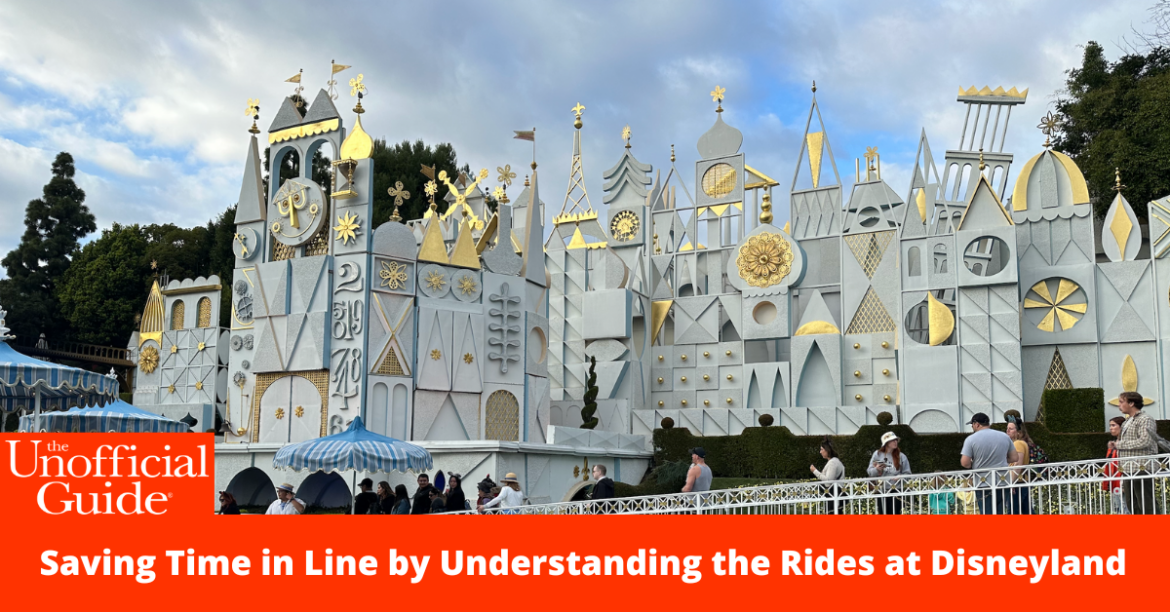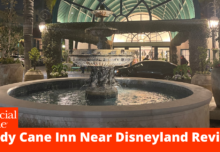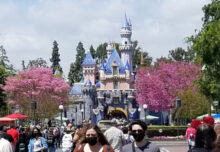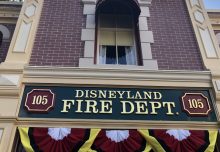There are many types of rides in Disneyland. Some rides, such as It’s a Small World, are engineered to carry several thousand people every hour. At the other extreme, rides such as Dumbo can accommodate only around 500 people an hour. Most rides fall somewhere in between, so we provide for each attraction an estimate (based on published information and our own observations) of its typical guest throughput, assuming normal operating conditions. Lots of factors figure into how long you will have to wait to experience a particular ride: the popularity of the ride, how it loads and unloads, how many people can ride at one time, how many units (cars, rockets, boats, flying elephants, or whatever) of those available are in service at a given time, and how many staff are available to operate the ride. Let’s take them one by one:

1. HOW POPULAR IS THE RIDE? Newer rides such as WEB SLINGERS: A Spider-Man Adventure or Star Wars: Rise of the Resistance attract a lot of people, as do longtime favorites such as Space Mountain. If you know a ride is popular, you need to learn a little more about how it operates to determine when might be the best time to ride.

2. HOW DOES THE RIDE LOAD AND UNLOAD? A ride need not be especially popular to form long lines. The lines can be the result of less-than- desirable traffic engineering; that is, it takes so long to load and unload that a line builds up. This is the situation at the Mad Tea Party and Dumbo. Only a small percentage of the visitors to Disneyland Park (mostly kids) ride Dumbo, for instance, but because it takes so long to load and unload, this ride can form long waiting lines.
Some rides never stop. They are like a circular conveyor belt that goes around and around. We call these continuous loaders. Haunted Mansion is a continuous loader. The more cars or ships or whatever on the conveyor, the more people can be moved through in an hour. Haunted Mansion has lots of cars on the conveyor belt and consequently can move more than 2,400 people an hour.

Other rides are interval loaders. This means that cars are unloaded, loaded, and dispatched at certain set intervals (sometimes controlled manually and sometimes by a computer). Matterhorn Bobsleds is an interval loader. It has two separate tracks (in other words, the ride has been duplicated in the same facility). Each track can run up to 10 sleds, released at 23-second or greater intervals (the bigger the crowd, the shorter the interval). In another kind of interval loader, such as the Jungle Cruise, empty boats return to the starting point, where they line up waiting to be reloaded.

In a third type of interval loader, one group of riders enters the vehicle while the last group of riders departs. We call these in-and-out interval loaders. Indiana Jones Adventure is a good example of an in-and-out interval loader. As a troop transport pulls up to the loading station, those who have just completed their ride exit to the left. At almost the same time, those waiting to ride enter the troop transport from the right. The troop transport is released to the dispatch point a few yards down the line, where it is launched according to whatever time interval is being used. Interval loaders of all three types can be very efficient at moving people if (1) the release (launch) interval is relatively short and (2) the ride can accommodate a large number of vehicles in the system at one time. Because many boats can be floating through Pirates of the Caribbean at a given time and the release interval is short, almost 3,400 people an hour can see this attraction.

A third group of rides are cycle rides. Another name for these same rides is stop-and-go rides; those waiting to ride exchange places with those who have just ridden. The main difference between in-and-out interval rides and cycle rides is that with a cycle ride, the whole system shuts down when loading and unloading is in progress. While one boat is loading and unloading in It’s a Small World, many other boats are proceeding through the ride. But when Dumbo touches down, the whole ride is at a standstill until the next flight is launched.

In discussing a cycle ride, the amount of time the ride is in motion is called ride time. The amount of time that the ride is idle while loading and unloading is called load time. Load time plus ride time equals cycle time or the time expended from the start of one run of the ride until the start of the succeeding run. Cycle rides are the least efficient of all the Disneyland rides in terms of traffic engineering. Disneyland Park has six cycle rides, while DCA has eight, an astonishing number for a modern park.
3. HOW MANY PEOPLE CAN RIDE AT ONE TIME? This figure is defined in terms of per-ride capacity or system capacity. Either way, the figures refer to the number of people who can ride at the same time. Our discussion above illustrates that the greater a ride’s carrying capacity (all other things being equal), the more visitors it can accommodate in an hour.
4. HOW MANY UNITS ARE IN SERVICE AT A GIVEN TIME? A unit is simply a term for the vehicle you sit in during your ride. At the Mad Tea Party the unit is a teacup, and at Alice in Wonderland it’s a caterpillar. On some rides (mostly cycle rides), the number of units in operation at a given time is fixed. Thus, there are always 16 elephant units operating on the Dumbo ride, 72 horses on King Arthur Carrousel, and so on. What this fixed number of units means to you is that there is no way to increase the carrying capacity of the ride by adding more units. On a busy day, therefore, the only way to carry more people each hour on a fixed-unit cycle ride is to shorten the loading time (which, as we will see in number 5, is sometimes impossible) or by decreasing the riding time, the actual time the ride is in motion. The bottom line on a busy day for a cycle ride is that you will wait longer and be rewarded for your wait with a shorter ride. This is why we try to steer you clear of the cycle rides unless you are willing to ride them early in the morning or late at night.

Other rides at Disneyland can increase their carrying capacity by adding units to the system as the crowds build. Big Thunder Mountain Railroad is a good example. If attendance is very light, Big Thunder can start the day by running one of five available mine trains. When lines start to build, more mine trains can be placed into operation. At full capacity, a total of five trains can carry about 2,400 people an hour. Sometimes a long line will disappear almost instantly when new units are brought online. On the other hand, the queue may stop altogether for a few minutes while new units are added, extending the wait for guests who were about to board. When an interval-loading ride places more units into operation, it usually shortens the dispatch interval, so more units are being dispatched more often.

5. HOW MANY CAST MEMBERS ARE AVAILABLE TO OPERATE THE RIDE?
Allocation of additional staff to a ride can allow extra units to be placed in operation, or additional loading areas or holding areas to be opened. Pirates of the Caribbean and It’s a Small World can run two separate waiting lines and loading zones. Haunted Mansion has a short preshow, which is staged in a “stretch room.” On busy days a second stretch room can be activated, thus permitting a more continuous flow of visitors to the actual loading area. Additional staff make a world of difference on some cycle rides. Often, if not usually, one attendant will operate the Golden Zephyr. This single person must clear the visitors from the ride just completed, admit and seat visitors for the upcoming ride, check that all zephyrs are properly secured (which entails an inspection of each zephyr), return to the control panel, issue instructions to the riders, and finally, activate the ride (whew!). A second attendant allows for the division of these responsibilities and has the effect of cutting loading time by 25%–50%.
If you visit Anaheim, you will want to get The Unofficial Guide to Disneyland. If you enjoyed this post, please subscribe to our YouTube channel and sign up for our newsletter here. Be sure to follow us on Threads, X, Facebook, Instagram, Pinterest, and YouTube. #unofficialguide #theUGSeries





